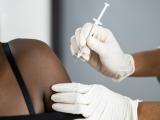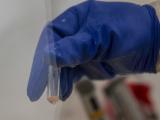Aug 1, 2003 (CIDRAP News) – A person exposed to a heavy dose of airborne anthrax spores would need to take antibiotics for at least 4 months to avoid illness, twice as long as the regimen used after the anthrax attacks of 2001, according to a study published in the Proceedings of the National Academy of Sciences.
Mathematical modeling indicates that the optimum duration of antibiotic treatment depends largely on the dose of inhaled anthrax spores, according to the report by Ron Brookmeyer and colleagues at the Johns Hopkins Bloomberg School of Public Health and Johns Hopkins School of Medicine in Baltimore.
"At high doses, we show that exposed persons would need to remain on antibiotic prophylaxis for at least 4 months, and considerable morbidity would likely occur before antibiotic prophylaxis could even be initiated," they write. "At very low doses, 60 days of antibiotic prophylaxis is adequate."
The authors based their model largely on data from experiments in which monkeys were exposed to anthrax spores. The experimental evidence suggests that spores lodged in the lungs are cleared at the rate of about 7% per day, that the germination rate for spores in the body is much lower than 7% per day, that about 15% of inhaled spores actually reach the lungs, and that a dose sufficient to kill 50% of those exposed (LD50) may range anywhere from 4,000 to nearly 100,000 inhaled spores. Data from the 1979 anthrax accident at Sverdlovsk in the Soviet Union supports the 7% clearance rate indicated by the primate studies, the report says.
The model indicates that if a person were exposed to an anthrax dose sufficient to be toxic to at least 50% of people (TD[50]), it would take at least 4 months of antibiotic treatment to reduce the risk of illness to less than 1 in 10,000. Smaller doses would permit shorter treatment regimens. For example, someone exposed to TD(1) (a dose sufficient to sicken 1% of people) would need 66 days of treatment.
The authors suggest that in an actual anthrax outbreak, their modeling approach can be used to estimate anthrax exposure doses on the basis of observed attack rates before the initiation of antibiotic prophylaxis. In applying this approach to data from the 2001 anthrax attacks, they estimate that the anthrax doses ranged from TD(0.4) to TD(0.6) at three of the involved sites—postal facilities in Washington, DC, and Hamilton, NJ, and a media publishing company in Florida.
Those exposed in the 2001 attacks were advised to take prophylactic antibiotics for 60 days, but compliance at the three sites was modest, ranging from 31% to 64%, the report says. "The fact that no anthrax cases surfaced among persons who initiated but may have prematurely discontinued antibiotic prophylaxis should not be surprising because the doses of inhaled spores were low," it states.
Brookmeyer R, Johnson E, Bollinger R. Modeling the optimum duration of antibiotic prophylaxis in an anthrax outbreak. Proc Natl Acad Sci 2003 (online early release Jul 28, 2003) [Abstract]



















